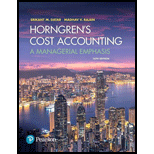
Concept explainers
Define cost pool, cost tracing, cost allocation, and cost-allocation base.
Costing:
Costing is a technique used in cost accounting to determine the cost of a product. With the optimum use of costing, a company can reduce the cost burden and increase the profit margin.
To explain: cost pool, cost tracking, cost allocation and cost allocation base.
Answer to Problem 4.1Q
- Cost pool: The cost accountant make individual group of all the indirect cost used in an item.
- Cost tracking: Cost tracking means the historical record of all the information of cost as it is useful to decide the selling price.
- Cost allocation: The process of assigning the cost to the cost object is cost allocation.
- Cost allocation basis: It is a factor on which the cost accountant allocates the overhead cost.
Explanation of Solution
- In cost pool, the production department makes groups of the individual cost to simplify the cost accounting process.
- Cost tracing is a method in which the cost accountant records each and every cost related to the product, so that it is easy to determine the selling price of the product.
- Cost allocation is simply to allocate cost for the specific cost object.
- Cost allocation basis is to allocate cost on the basis of units for example the cost allocation basis is number of machine hours.
Thus, the meaning of cost pool, cost tracking, cost allocation and cost allocation base is explained above.
Want to see more full solutions like this?
Chapter 4 Solutions
Horngren's Cost Accounting: A Managerial Emphasis (16th Edition)
Additional Business Textbook Solutions
Business Essentials (12th Edition) (What's New in Intro to Business)
Essentials of Corporate Finance (Mcgraw-hill/Irwin Series in Finance, Insurance, and Real Estate)
Corporate Finance (4th Edition) (Pearson Series in Finance) - Standalone book
Operations Management
Operations Management: Processes and Supply Chains (12th Edition) (What's New in Operations Management)
Principles of Economics (MindTap Course List)
- Branton Ltd. had cash sales of $56,390, credit sales of $42,810, sales returns and allowances of $6,450, and sales discounts of $5,120. The company's net sales for this period___. A. $88,200 B. $87,630 C. $92,180 D. $93,830 E. $95,900arrow_forward5 PTSarrow_forwardWhat is the gross profit margin of this accounting question?arrow_forward
- What is the differential revenue?arrow_forwardDon't use ai given answer general accountingarrow_forwardArdor Ltd. purchased a new equipment that is expected to be used in operations for 6 years for $60,000. The salvage value of the equipment after 6 years is $6,000. Assume the equipment was purchased on the first day of the fiscal year so no partial-year depreciation is needed. Using the Straight-Line Depreciation Method, what is the value of accumulated depreciation at the end of year 4?arrow_forward
 Cornerstones of Cost Management (Cornerstones Ser...AccountingISBN:9781305970663Author:Don R. Hansen, Maryanne M. MowenPublisher:Cengage LearningPrinciples of Accounting Volume 2AccountingISBN:9781947172609Author:OpenStaxPublisher:OpenStax College
Cornerstones of Cost Management (Cornerstones Ser...AccountingISBN:9781305970663Author:Don R. Hansen, Maryanne M. MowenPublisher:Cengage LearningPrinciples of Accounting Volume 2AccountingISBN:9781947172609Author:OpenStaxPublisher:OpenStax College Managerial AccountingAccountingISBN:9781337912020Author:Carl Warren, Ph.d. Cma William B. TaylerPublisher:South-Western College Pub
Managerial AccountingAccountingISBN:9781337912020Author:Carl Warren, Ph.d. Cma William B. TaylerPublisher:South-Western College Pub Survey of Accounting (Accounting I)AccountingISBN:9781305961883Author:Carl WarrenPublisher:Cengage Learning
Survey of Accounting (Accounting I)AccountingISBN:9781305961883Author:Carl WarrenPublisher:Cengage Learning Principles of Cost AccountingAccountingISBN:9781305087408Author:Edward J. Vanderbeck, Maria R. MitchellPublisher:Cengage Learning
Principles of Cost AccountingAccountingISBN:9781305087408Author:Edward J. Vanderbeck, Maria R. MitchellPublisher:Cengage Learning College Accounting, Chapters 1-27AccountingISBN:9781337794756Author:HEINTZ, James A.Publisher:Cengage Learning,
College Accounting, Chapters 1-27AccountingISBN:9781337794756Author:HEINTZ, James A.Publisher:Cengage Learning,





